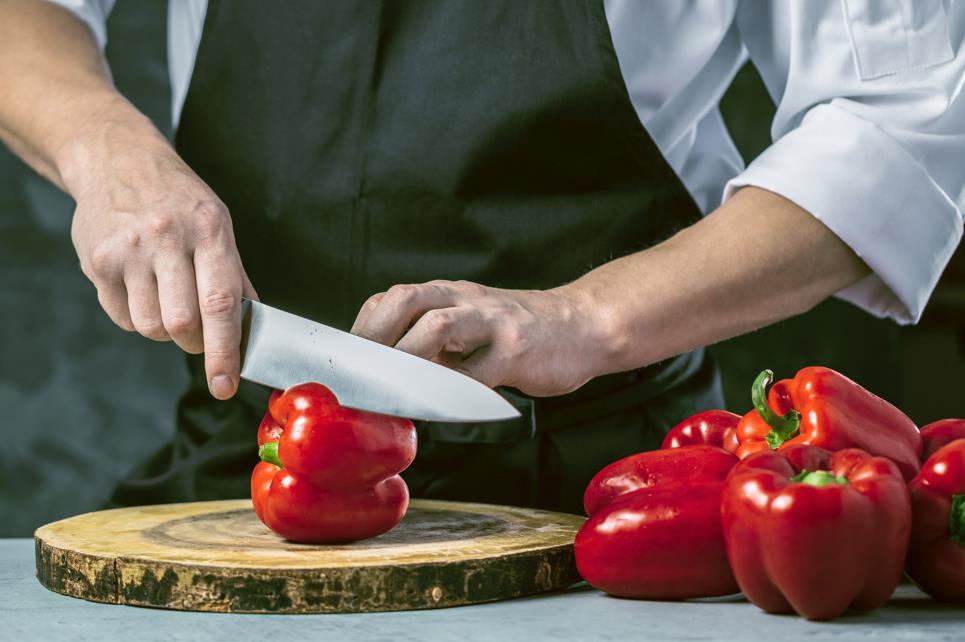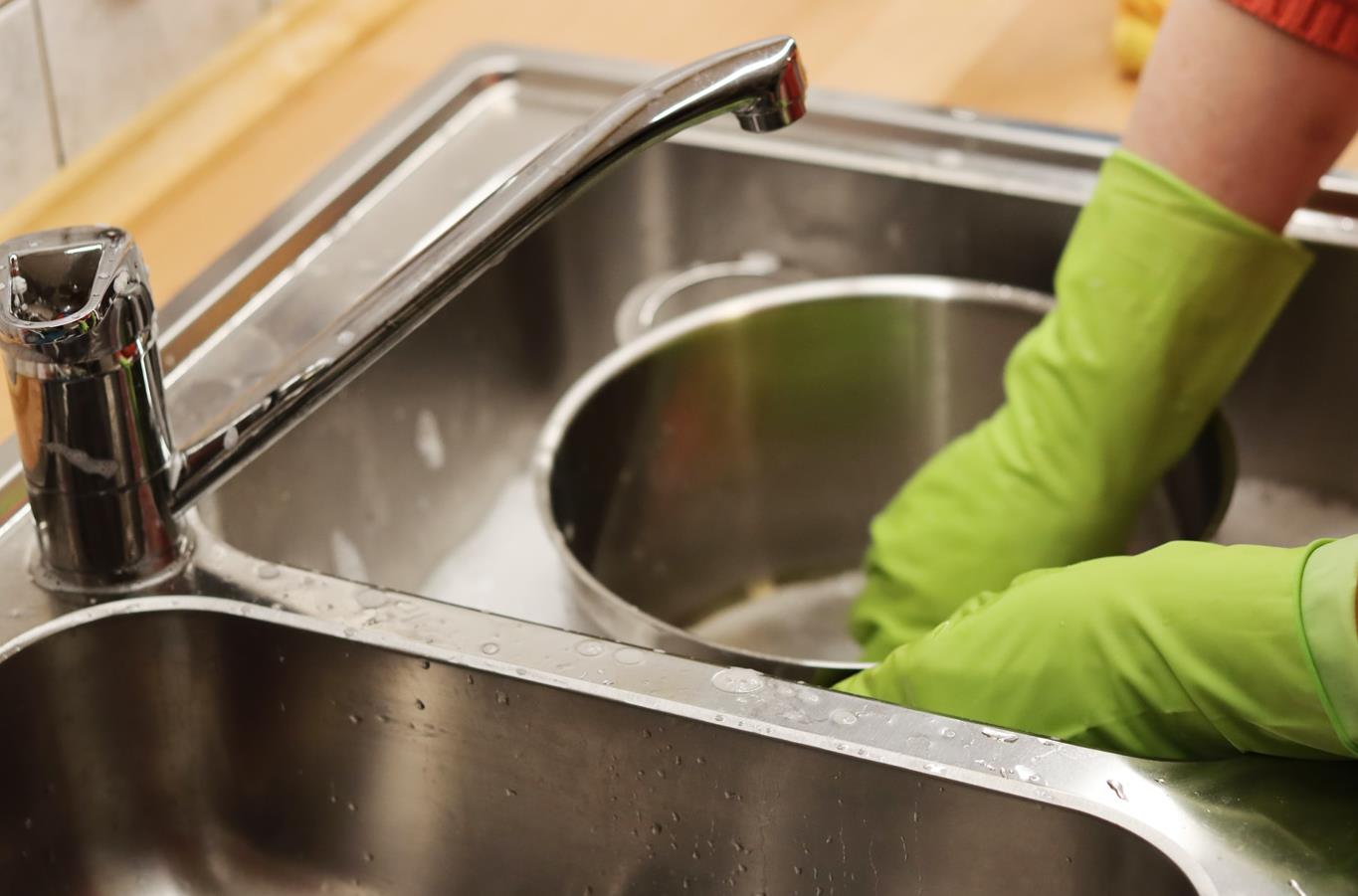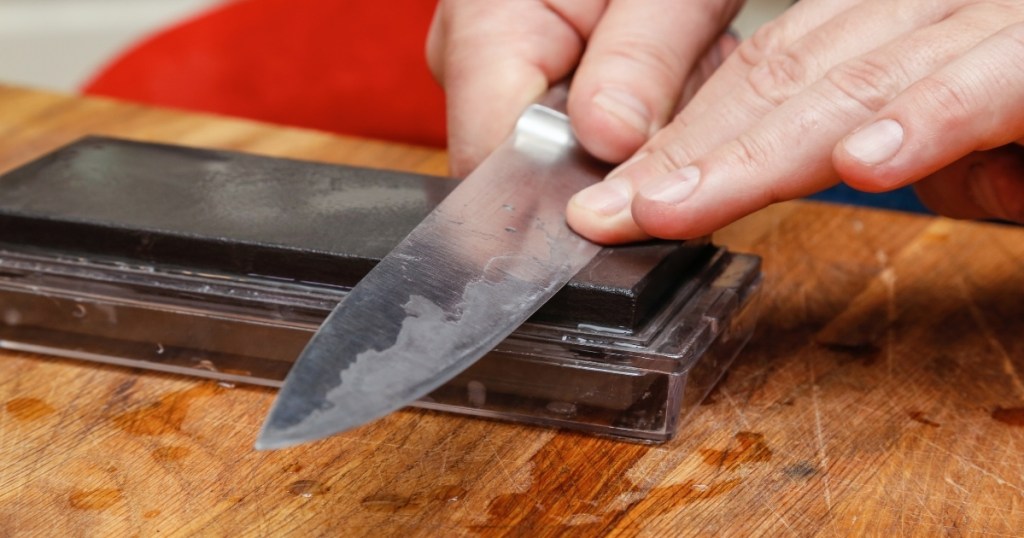While almost everyone has heard of a Chef’s knife, few are familiar with Santoku knives. The Santoku vs Chef knife competition is a long-lasting debate among chefs. Both blade varieties have different origins, designs, and uses, but are essential tools in virtually all homes and professional kitchens.
Chef’s knives are robust, all-round tools, capable of performing most cutting tasks. Their features include a pronounced tip and a double bevel. They usually have a large bolster too, though not always. Classic Western Chef knives are not the hardest, but very tough.
Santoku knives are smaller, sharper, and typically made from harder steel. They are not as sturdy as chef’s knives yet can cut much thinner slices.
As an amateur or experienced chef, a good knife is critical to preparing dishes efficiently and to a high standard. As such, it is important to know the exact features of these two knives, what they look like, and finally, which is best for you. Read into this guide will help make that decision easier.
Table of contents
What is a Santoku knife?

Origins
A santoku knife doesn’t look very different from a standard chef’s knife, but its beginnings are virtually opposite. It derives from old Japanese vegetable knives, which have a rectangular shape. You may have guessed from the name alone that it is Japanese. The Santoku knife’s full name is ‘Santoku Bocho’, which means three uses.
It is not clear whether this refers to three relevant cutting actions (chopping, dicing, and slicing) or three food applications (vegetables, meat, and fish). The city of Seki in Japan is considered the country’s center for producing cutlery and knives and was one of the first places to produce the Santoku variety.
Design & features
A Santoku knife is usually between 5 and 8 inches in length. Its cutting edge is nearly straight and has a subtle tip. The spine curves down from the handle to meet the edge at the Santoku’s point. Between the handle and the blade, there can be either a small bolster or no bolster.
Santoku knives can have a single or double bevel, though the latter is far more common. This means that one or both surfaces of the blade can have a sharpened edge. With a single bevel, it is possible to create a smaller angle (15-20°) on the knife’s edge, thereby making it sharper.
These knives can also have Granton edges. In this case, one side of the blade features a line of dents to make it easier to clean food off the knife.
A Santoku knife can come in ceramic varieties, but the most common material is high carbon steel. This makes the blade hard but also somewhat brittle. Santoku knives are lightweight and small and therefore great for smaller-handed cooks.
Performance
Due to its flatter edge and less curved knife tip, a Santoku requires a special cutting technique. Rather than a rocking motion, users need to cut into ingredients with a more direct vertical push.
A Santoku’s sharp blade can yield very thin slices of food. This is especially useful in Japanese cuisine, which helps to explain this knife’s birthplace. Overall this type of knife is ideal for slicing meat, fish, cheese, fruit, vegetables, and for chopping herbs.
You should probably avoid using a Santoku for very tough jobs such as sawing bones or hard bread. Although they can be made from hard ceramic or steel, those food items could snap the Santoku blade.
What is a chef knife?

Origins
The modern Chef’s knife can trace its origins to Germany and France. The city of Solingen in Germany contains evidence of metalworking and forging of knives, going back hundreds of years. Swords made in Solingen were exported all around Europe. Today, the Solingen brand is one of the world’s finest knife manufacturers and is named directly after the city.
The French also influenced Chef knives that we use today by creating their own design. After all, the word “Chef” itself is French.
Design & features
Modern Chef’s knives are 8 inches long on average. That said, you can find some up to 14 inches in length. The cutting edge of a Chef’s knife is curved and has a distinct tip at the end. The knife’s spine is also curved and thick to make the blade heavier.
A Chef’s knife can normally only be found with a double bevel edge. Most Chef knives have flat surfaces, but they can also have Granton edges.
French- and German-style Chef’s knives are usually manufactured with softer stainless steel than the Santoku, so they do not stay as sharp over time. They are more durable though, which means that dropping or being rough with a Chef’s knife will not necessarily break it.
However, much like the Santoku variety, Chef’s knives don’t have to be made from steel. Nowadays, you can find plenty of ceramic knives on the market too. In comparison to the Santoku, Chef’s knives are longer and heavier.
Performance
The curved edge of a Chef’s knife naturally causes a rocking motion because it can chop without leaving the cutting board. As the user pushes to cut into food, the upward curve of the tip can stay on the chopping board as the knife rolls forwards and upwards. The result is that Chef’s knives are not quite as precise as a Santoku and so do not cut as thinly.
Despite being less precise than a Santoku, a Chef’s knife is more versatile. You can use it to prepare most ingredients and cuisines. The tip of a Chef’s knife is very useful for more delicate tasks like chopping onions, garlic, or for cutting food into strips.
The standard technique is for cooks to grasp the handle with the thumb and four fingers. An alternative position is to hold the actual blade with the index finger and thumb, with the other fingers gripping the handle. Many cooks prefer the latter when using a chef’s knife, however, each technique is appropriate for both knives.
How are they similar?
Santoku and Chef’s knives are both extremely popular, multi-use kitchen knives. You can find either style of knife with a steel or ceramic blade. Both knives can have double bevel edges or Granton edges as well.
Truthfully, the Santoku is a type of specialized Chef knife. They have design features in common, but the Santoku shape is more suited to the cutting style of a Japanese chef. Both can have handles with numerous materials ― wood, metal, bone, carbon fiber, and many more
Although they originate from different continents, both knives have foundations in countries with strong metalworking and sword-making traditions. Japan and Germany are renowned for manufacturing high-quality products in many industries. This explains the successful Santoku and Chef knife designs, plus their continued worldwide popularity today.
Santoku vs Chef knife: the key differences
| Santoku Knife | Chef’s Knife | |
| Place of origin | Seki, Japan | Solingen, Germany (and France) |
| Size | Between 5 and 8 inches long. | Between 6 and 14 inches long. |
| Blade shape | A mostly flat cutting edge with a sheepsfoot blade. | A curved cutting edge with an obvious tip. The spine is also curved and weighted. |
| Features | This is sometimes made with a single bevel. | This is always made with a double bevel. |
| Material properties | Its blade can be made from ceramics, but high carbon steel is more common. This material is very hard and can be made very sharp. Although, it is quite brittle and might chip. | Ceramic Chef knives are increasingly common. However, professional chefs often prefer stainless steel. This is softer than high carbon steel, so is more prone to scratches. On the other hand, stainless steel is more flexible and hence less likely to crack. |
| Applications | There are many. It can cut precisely and works well with most meat, fish, and fruit. It is not ideal for tougher items like bones or hard fruits. | This is a versatile, well-rounded choice, suited to most cutting tasks. It can slice through harder ingredients but is not the most precise. |
| Cutting technique | The shape of the blade is flat and requires more direct vertical movements to cut through foods. The less pronounced tip means this knife doesn’t naturally roll, although this technique is possible. | The curved blade shape lends itself to a rocking motion. While chopping something, the knife tip never has to leave the cutting board as the whole knife goes up and down. |
How to maintain Santoku vs chef knife
Cleaning

Regardless of which knives you have in your collection, knowing how to clean them should be one of your top priorities. In a kitchen environment, you can never be too clean. If you use a knife to cut through raw meat and fish, failing to clean it properly puts you and others at great risk of food poisoning. This is especially important if you plan to cut multiple ingredients for separate dishes.
Not cleaning a knife thoroughly is a bad idea too ― you might think that you have done a good job, but bacteria can still exist on the blade or handle. In addition, improper cleaning techniques may damage the structure or finish of the blade. That is the last thing you want for your brand new Santoku knife or Chef knife.
The cleaning process is the same irrespective of the knife or its material. Once you have finished using it you should rinse the entire length of the knife in hot water with soap and a sponge. This is guaranteed to kill almost all bacteria. Leaving knives to soak in warm water in a sink actually helps bacteria to grow.
As you clean the surface of the blade, make sure to move the sponge away from your body. This reduces any risk of cutting or poking yourself with the knife. If there are some very tough food stains or particles on the knife, it is fine to soak it in hot water, but not for too long. Leaving a knife in boiling water for more than a couple of minutes can distort the handle or cause rust to form.
If you wish to avoid rust on the knife completely, it is wise to gently dry it with a clean towel after washing. Dishwashers should be avoided because other utensils inside can blunt and damage the knife blade. It is also important to store a Santoku or Chef knife away from cutlery that can scratch the blade ― you can perhaps place it safely in a separate box.
Sharpening

Keeping a kitchen knife sharp is another crucial part of caring for it. A blunt knife is more dangerous than a sharp knife since it forces you to push harder, thereby increasing the chances of it slipping and injuring you. Because of the reduced effort, you can prepare dishes much faster and stress-free when your knife is sharp.
Handpicked for you
True cutting power in the palm of your hand
As you use a new knife the sharp cutting edge is slowly blunted through repetitive sliding across food surfaces that you cut. The purpose of knife sharpening is to retain the original angle of the blade when it was new.
Santoku knives are usually made from harder steel than a Chef’s knife. This allows Santoku knives to stay sharper for longer. Chef’s knives need to be sharpened more frequently for them to remain effective. It is worth remembering that sharpening a knife involves removing fragments of metal from the blade. Sharpening wears a knife down in the long run, so you should only do this when necessary.
Santoku
If you have a Santoku chef knife, the recommended method of sharpening is with a whetstone. With a single bevel, you can focus on perfecting the finish on one side of the blade. Note that, without a bolster, the sharpening process is smoother for Santoku knives since nothing blocks the knife as it slides back and forth.
A whetstone is a block of hard stone with sharp edges. Whetstones nowadays are available with dual textures i.e. rough on one half and fine on the other. Soaking the whetstone before you start sharpening should make the process easier.
Firstly you should slide the blade along the rougher side of the whetstone, making sure to maintain the correct angle. For safety reasons, you should push the knife away from your body, then reset and slide it along again. You must sharpen the blade’s entire length and try to use as much of the whetstone’s edge as you can. That way you will avoid wearing down one section of the stone.
If the Santoku has a double bevel, then you should repeat this step for both sides of the blade. Otherwise, the next step is to sharpen the Santoku on the fine side of the whetstone. Once you are satisfied with the knife’s sharpness, it is sensible to rinse it to remove any excess metal fragments.
Chef knife
A Chef’s knife with its double bevel and softer steel does not require such a powerful sharpening tool as the whetstone. It may be enough to use the honing technique instead. This entails sliding a steel rod along both sides of the knife edge.
The right technique is to hold the knife in one hand and the rod in the other. You should tuck all fingers of both your hands into the handles ― you might badly cut your fingers if you do not. The two tools should cross over in an X formation in front of you and you should push them into one another. While maintaining this pressure, you should steadily slide the knife perpendicular to the rod from heel to tip.
Rather than moving the knife quickly, it is important to keep a consistent angle. When you have completed one swiping motion, reset the knife and repeat. You may need to slide both sides of the blade along the steel rod several times. Note that honing does not sharpen a knife ― it only re-aligns the blade edge.
Are there any differences between French- & German-style chef knives?
Yes. If you look closely at the modern Chef’s knife you will see two main varieties. These are the French and German styles. The French type has a blade whose edge curves up gradually towards the knife tip. The blade of a french knife has an overall slimmer and longer appearance.
The German-style Chef knife has a more pronounced curve on its blade edge and is shorter and thicker in appearance. These two knives look noticeably different when viewed side-by-side, but they still have more in common with each other than with a Santoku.
What are the other types of chef knives?

The Santoku, French, and German knives are not the only styles important to professional and home cooks. Chef’s knives can also have serrated blades which are perfect for slicing bread. These blades have many individual spikes that pierce food surfaces simultaneously. Serrated knives do not offer the smoothest slicing motion. They are also tricky to sharpen.
A utility knife is a miniature version of a normal Chef’s knife and has similar capabilities. It is ideal for chopping small pieces of food which larger knives cannot accurately handle.
The traditional Chinese Chef’s knife looks very different from most other kitchen knives. The Chinese tool has a completely rectangular blade. Its nearest equivalent is probably a meat cleaver.
What are the other common Japanese knives?
Japan has an established tradition of sword making ― Samurai swords are well-known all around the world. Japanese sword expertise has translated into excellent kitchen knives too.
The Gyuto (which translates to ‘beef sword’) is the closest Japanese knife to the Western Chef’s knife. The main distinction is that the Japanese version weighs less, is thinner, and is made from harder steel.
The Nakiri is a vegetable knife that looks quite similar to the rectangular Chinese Chef’s knife. It is used to slice through the tough skin and flesh of various fruits and vegetables.
The Honesuki is a Japanese boning knife that features a triangular blade. Honesuki knives are effective at extracting bones from poultry and fish, plus they can cut through tough layers of cartilage and fat.
Chef’s knives are a more well-rounded choice for beginners
However, a Santoku knife is still very versatile and can deal with most of your cutting needs in the kitchen. The solid build and softer material in a Chef’s knife make it more forgiving for amateurs in case they drop it. Remember that a Chef’s knife will need sharpening more often than a Santoku, so this is a skill you should practice.
If you are interested in finding a high-performance knife for your cooking, be sure to check out our store.













